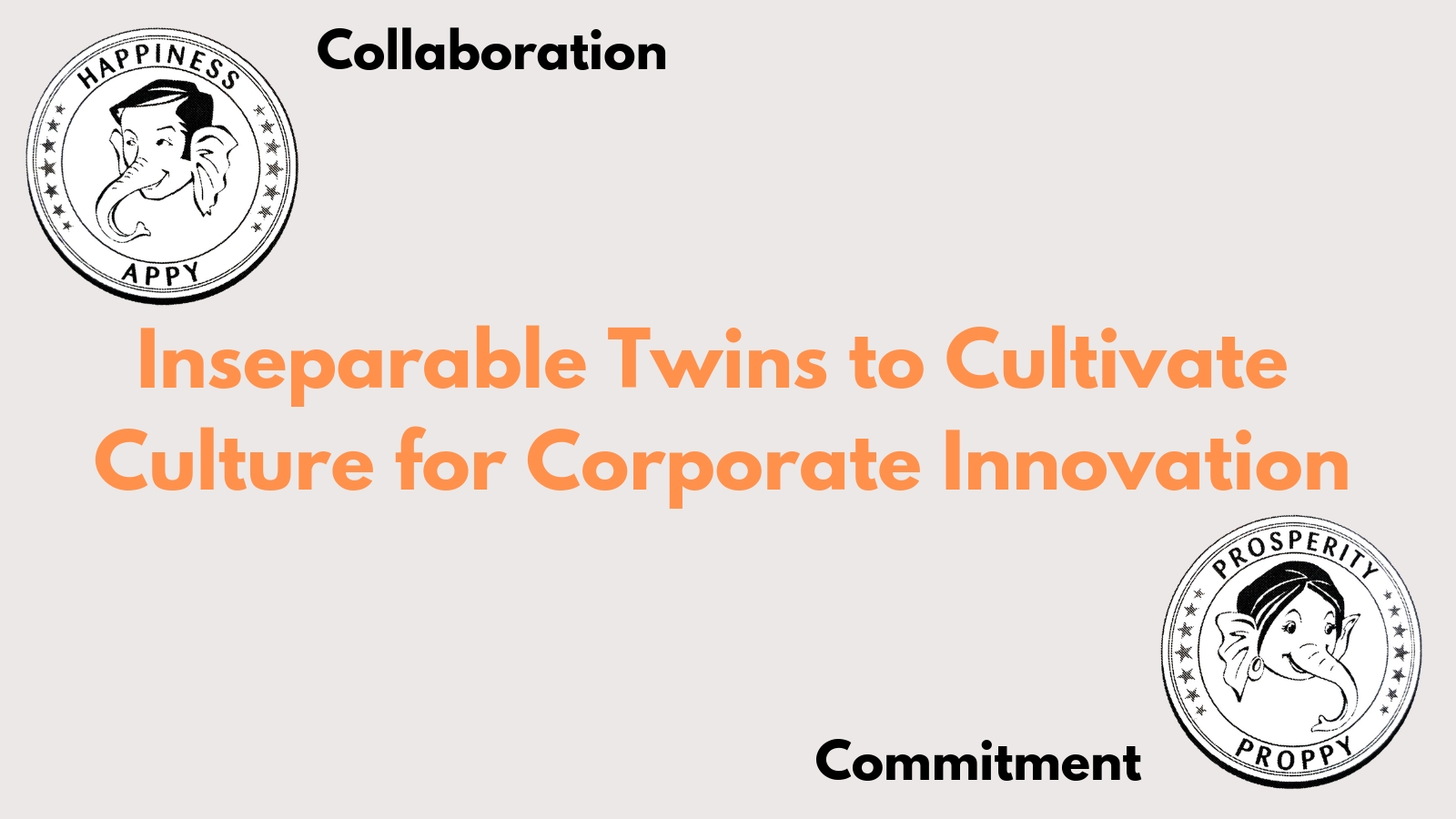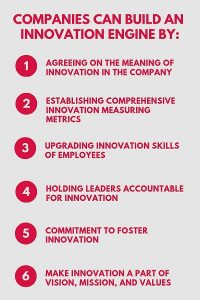Cultivating Culture for Innovation within a Corporate – by Naveen Lakkur

After waking up early in the morning, Appy an elephant tusker with great powers and his name synonym to ‘Happiness’ went to the living room to join his twin sister Proppy drinking her morning sugarcane juice.
Proppy a sharp and beautiful elephant with her name synonym to ‘Prosperity’. Both Appy & Proppy love humans so much so that they have transformed themselves into human forms.
“Had a nice sleep bro?” asked Proppy. Appy nodded in an affirmative. “Your sugarcane juice is ready”, said Proppy.
“Thanks sis. You know I dreamt about the world governments banning innovation. People had to use the old archaic stuff we used in the 70s. What a dream to have”, said Appy.
“Hmm. Strange dream. I think it got me thinking. If there is no innovation at all, will organizations collapse like pack of cards?” wondered Proppy.
Before Appy could respond with an answer, Proppy jumped in, “Don’t worry giving me a half-baked answer, I already sent a message to Lucky asking him how companies can cultivate the culture for innovation. He said he’s on the way to an event. He will drop by to give us the answer.”
Just then they heard a rumble of loose gravel outside their home. They heard the engine switch off, and the door open and close.
“That must be Lucky. I will get the door”, said Proppy.
Lucky, their human mentor who was mentoring them about intricacies of entrepreneurship and innovation had a leather jacket and a cooling glass on.
“Do you age Lucky?” asked Proppy.
Lucky laughed, sat on the couch and said, “you two look good too.”
“I got your message Proppy, so I thought I would drop by before heading out to town to attend a talk”.
Appy brought Lucky a glass of sugarcane juice. He took a sip and began talking.
“So how do we create culture for innovation?” began Lucky drawing a machine with his hands in the air.
Appy and Proppy listened intently.
 “I understand now, companies need ‘Commitment’ to build culture for innovation”, said Appy and Proppy said at the same time, This is just like all the important internal organs like the heart, brain, kidney, and the lungs, which must work in unison to keep us functioning. So companies need ‘Collaboration’ to build culture for innovation”
“Correct, ‘Commitment’ & ‘Collaboration’ are Inseparable Twins to cultivate culture for innovation within a corporate”, said Lucky. “You may refer to the HBR article for further information.” He took a last sip of the juice, put the tumbler on the table and walked towards his car.
Appy and Proppy stood at the door, waving at him.
“One last wisdom. The Human Resource is the most worthy capital when it comes to innovation. So nurturing Human Capital to develop intellectual capital is the most effective way to cultivate culture for innovation within a company.”
“We agree. Thanks for teaching us Lucky”, said both the elephants together.
Alright my favorite pachyderms, time to say bye, until the next innovation puzzle.”
“I understand now, companies need ‘Commitment’ to build culture for innovation”, said Appy and Proppy said at the same time, This is just like all the important internal organs like the heart, brain, kidney, and the lungs, which must work in unison to keep us functioning. So companies need ‘Collaboration’ to build culture for innovation”
“Correct, ‘Commitment’ & ‘Collaboration’ are Inseparable Twins to cultivate culture for innovation within a corporate”, said Lucky. “You may refer to the HBR article for further information.” He took a last sip of the juice, put the tumbler on the table and walked towards his car.
Appy and Proppy stood at the door, waving at him.
“One last wisdom. The Human Resource is the most worthy capital when it comes to innovation. So nurturing Human Capital to develop intellectual capital is the most effective way to cultivate culture for innovation within a company.”
“We agree. Thanks for teaching us Lucky”, said both the elephants together.
Alright my favorite pachyderms, time to say bye, until the next innovation puzzle.”

Promoting Innovation Culture
“Innovation is not just about ideas, it is a whole package. It means getting everyone on board. The management too must support innovative people”, started Lucky. “If companies have a R&D team, the management need not have others to be innovative, right?” asked Proppy. “I will get to how management comes in. Before that, There are some requirements to fulfill to become an innovative company.” Appy and Proppy nodded in unison.Requirements of Innovative Companies
Lucky started by saying, “Let me take the support of an article by HBR illustrating a framework as requirements for building culture for Innovation. “The first requirement is that companies must define what is innovation to them. Companies must have a practical, agreed-upon definition of innovation to make it easy for them to set goals for innovation, to allocate resources for innovative projects, to target advertising, and to measure performance.” “The second requirement is, the companies must define innovation metric to measure innovation just like they measure every other corporate function. People at the top must create a dashboard to measure innovation based on the following:- The time and money put in towards the innovation, including employee time, number of ideas sourced internally and externally.
- The number of quality ideas chosen after screening, and time taken for the ideas to move from concept to prototype.
- The innovations that entered the market, and revenue derived from the products and services.
- Time devoted towards mentoring.
- Measure other things like training, process, efficiency, among others.”
- Demonstrating an appetite for unconventional ideas
- Freeing up time and money for innovation
- Eliminating bureaucratic impediments
- Avoiding judging of options prematurely
Looking Back at the Framework
“Looking at this framework, we can also say that innovation will not be complete with poorly integrated team, processes and tools. Along with the CEO, the top team must be on board. It is difficult to move a huge organization to use this framework for innovation. The HBR gives examples of Whirlpool throughout this article. You should read this article.” “Organizations with archaic practices need an ‘innovation architect’, responsible for design and construction of the company’s innovation engine. To this effect, companies these days hire Chief Innovation Officer along with the CFO and the CEO to initiate and oversee new initiatives.” “Well, let me conclude by saying companies can build an innovative engine by:- Arriving at an agreement on what innovation means in their company.
- Creating and establishing comprehensive metrics to measure innovation
- Upgrading every employee’s innovation skills.
- Enabling leaders and holding them accountable for innovation.
- Commitment by the management to foster innovation and make it part of their vision, mission and values.
 “I understand now, companies need ‘Commitment’ to build culture for innovation”, said Appy and Proppy said at the same time, This is just like all the important internal organs like the heart, brain, kidney, and the lungs, which must work in unison to keep us functioning. So companies need ‘Collaboration’ to build culture for innovation”
“Correct, ‘Commitment’ & ‘Collaboration’ are Inseparable Twins to cultivate culture for innovation within a corporate”, said Lucky. “You may refer to the HBR article for further information.” He took a last sip of the juice, put the tumbler on the table and walked towards his car.
Appy and Proppy stood at the door, waving at him.
“One last wisdom. The Human Resource is the most worthy capital when it comes to innovation. So nurturing Human Capital to develop intellectual capital is the most effective way to cultivate culture for innovation within a company.”
“We agree. Thanks for teaching us Lucky”, said both the elephants together.
Alright my favorite pachyderms, time to say bye, until the next innovation puzzle.”
“I understand now, companies need ‘Commitment’ to build culture for innovation”, said Appy and Proppy said at the same time, This is just like all the important internal organs like the heart, brain, kidney, and the lungs, which must work in unison to keep us functioning. So companies need ‘Collaboration’ to build culture for innovation”
“Correct, ‘Commitment’ & ‘Collaboration’ are Inseparable Twins to cultivate culture for innovation within a corporate”, said Lucky. “You may refer to the HBR article for further information.” He took a last sip of the juice, put the tumbler on the table and walked towards his car.
Appy and Proppy stood at the door, waving at him.
“One last wisdom. The Human Resource is the most worthy capital when it comes to innovation. So nurturing Human Capital to develop intellectual capital is the most effective way to cultivate culture for innovation within a company.”
“We agree. Thanks for teaching us Lucky”, said both the elephants together.
Alright my favorite pachyderms, time to say bye, until the next innovation puzzle.”

Chief Innovation Officer

Leave a comment